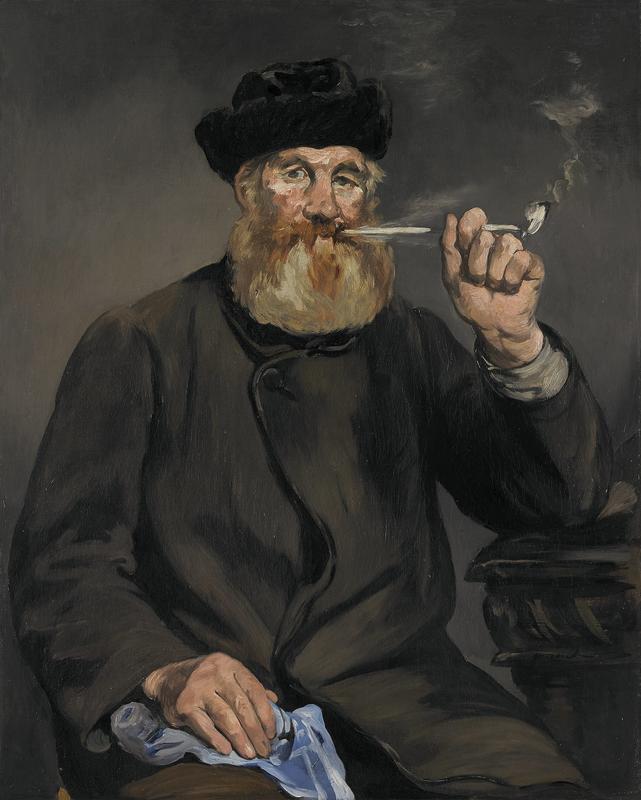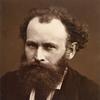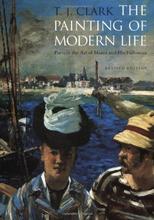More about The Smoker
- All
- Info
- Shop

Contributor
Edouard Manet paints his neighbor in The Smoker.
This jolly fella is not a character out of Tintin or Asterix and Obelix. The sitter is Joseph Gall, a fellow painter. Monet was inspired to paint "ordinary" folk by a recent trip to Madrid, where he became enamored by the work of Diego Velazquez that featured regular people like street vendors and old ladies making dinner. Manet had no trouble finding subjects, as he was surrounded by colorful characters in Paris. When Manet moved into his apartment on Rue Guyot in 1861, he met Gall and they hit it off instantly, with Gall posing for Manet in The Reader the same year they met. Back then, Gall was sporting a more clean-cut look, but we prefer the big and bushy bohemian beard he’s rocking here.
The Smoker was painted in early Autumn, and Gall looks cozy and ready for colder weather in his stylish coat and fur hat. The whole ensemble screams Paris Ready to Wear. In 1866, the same year as The Smoker, Manet was rejected by the Salon. How strange events can turn, only the previous year, the Salon was keen to exhibit Manet’s Olympia. Now Manet had to strike out on his own. The Smoker was thus exhibited at Manet’s one man show, a year later. Only the real fans were invited, of course.
Curators at the Minneapolis Institute of Art suggest that the rise of photography in the 19th century influenced Manet's work, in that portraits were no longer the sole method for producing someone's likeness. A portrait painting had to go deeper, and somehow provide a more meaningful representation of an individual. In this work, Manet is able to convey his respect for his friend, who looks out at the viewer with a dignified stare. As the MiA curators put it, Manet bestows upon Gall the sense of a "great intellect in a rough exterior."
The Smoker was given to the Minneapolis Institute of Art by Bruce Dayton, a collector and longest-running member to sit on the museum's board. Dayton was known for gifting artworks when milestones were reached. After the success of Dayton Corp. going public in the stock market, he donated The Smoker in 1967.
Sources
- Abbe, Mary, “Bruce Dayton: The art world’s quiet connoisseur,” Star Tribune, November 14, 2015. Accessed April 19, 2020. https://www.startribune.com/bruce-dayton-the-art-world-s-quiet-connoiss…
- Callen, Anthea, “Immaterial Views? Science, Intransigence and the Female Spectator of Modern French Art in 1879,” French Literature, Though and Culture in the Nineteenth Century: A Material World, edited by Brian Rigby. London: The Macmillan Press Ltd, 19
- Hanson, Anne Coffin, Edouard Manet, 1832-1883: Exhibition Philadelphia Museum of Art, November 3-December 11, 1966; the Art Institute of Chicago, January 13-February 19, 1967. Michigan: Falcon Press, 1966.
- Melikian, Souren, “The shifting style of Manet’s people,” The New York Times, January 25, 2013. Accessed April 19, 2020. https://www.nytimes.com/2013/01/26/arts/the-shifting-styles-of-manets-p…
- Nichols, Lawrence W., “A Good Smoke: Manet’s The Smoker in Context of his Portraiture,” Minneapolis Institute of Art, Accessed April 20, 2020. https://new.artsmia.org/event/a-good-smoke-manets-the-smoker-in-context…
- Peck, Aaron, “Reframing the black model at the Musee d’Orsay,” The New York Review of Books, June 22, 2019. Accessed April 20, 2020. https://www.nybooks.com/daily/2019/06/22/reframing-the-black-model-at-t…
- Wiese, Ellen Phoebe, Source Problems in Manet’s Early Painting. Radcliffe College, 1958.
- Zola, Emile, Looking at Manet. Getty Publications, 2018.













I like this painting because the name kind of sounds self-explanatory, almost too simplistic.